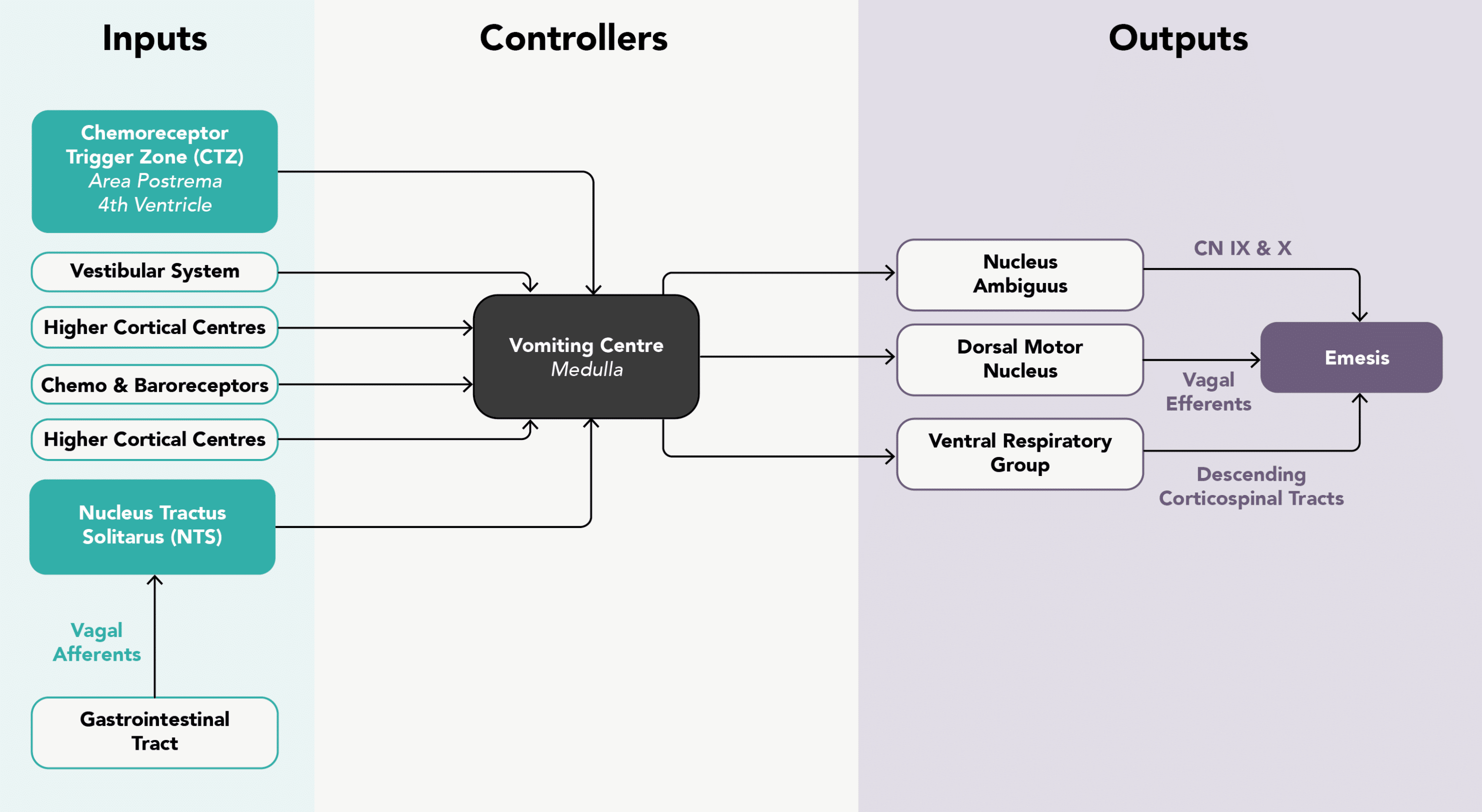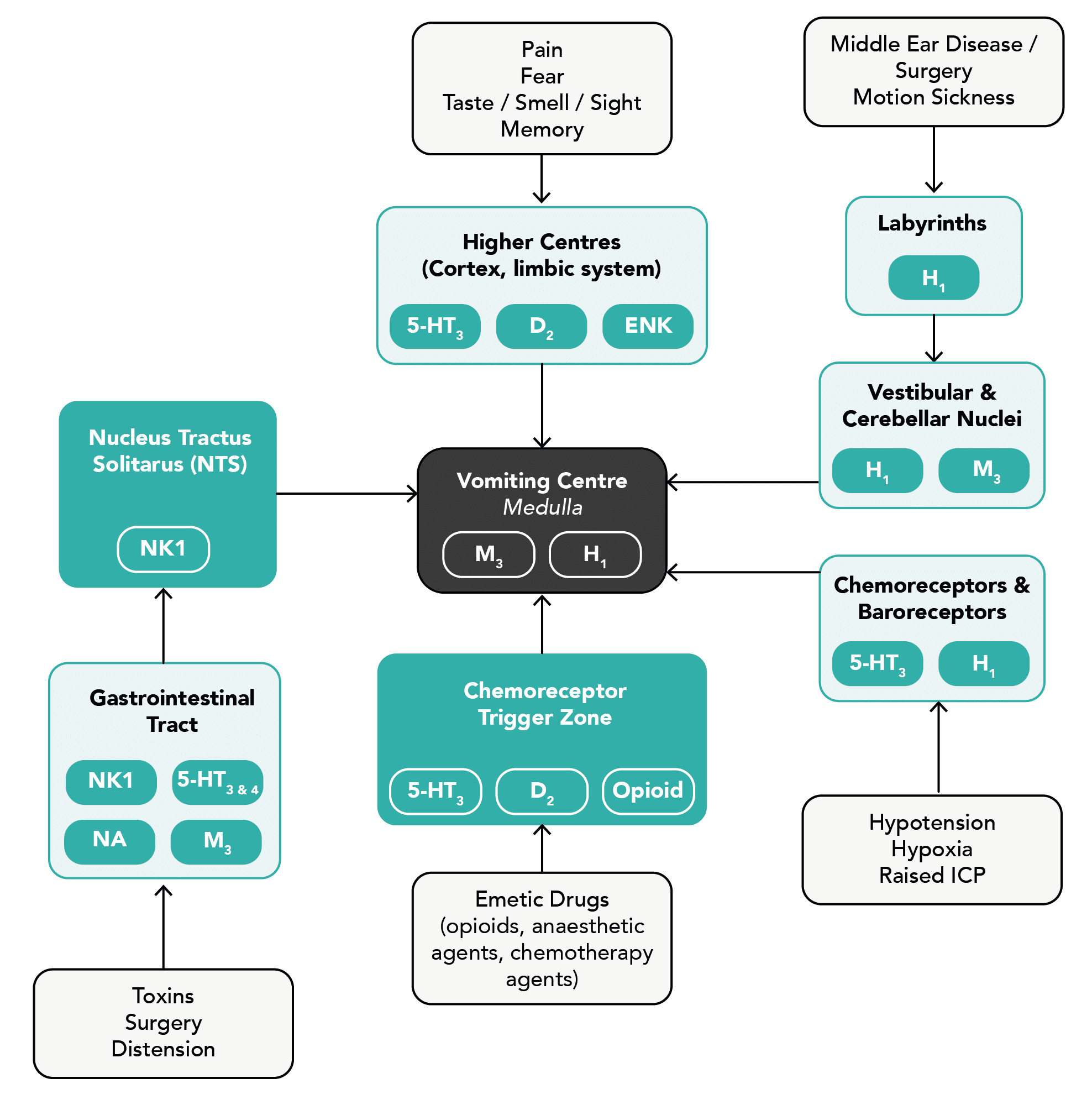RESOURCES
Review Articles
- Pierre, BJA Ed (2013); Nausea and Vomiting After Surgery
- Denholm, Anaes Int Care (2018); Physiology and pharmacology of nausea and vomiting
- Pleuvry, Anaes Int Care (2015); Physiology and pharmacology of nausea and vomiting
- Zhong, Int J Mol Sci (2021); Mechanisms of Nausea and Vomiting: Current Knowledge and Recent Advances in Intracellular Emetic Signaling Systems SI Units, Force, Mass and Acceleration
OBJECTIVES & QUESTIONS
Introduction & Definitions
How are nausea and vomiting defined?
Nausea: the sensation of the need to vomit
Vomiting: the involuntary, forceful expulsion of gastric contents via the mouth
Retching: the involuntary movements of vomiting without expulsion of vomitus
What are the complications of vomiting relevant to anaesthesia and intensive care?
- Simple vomiting rarely leads to medical complications
- Commonly leads to patient dissatisfaction following surgery
- However, severe cases can lead to:
- Increased length of hospital stay / delayed discharge
- Aspiration pneumonia
- Dehydration
- Metabolic alkalosis
- Electrolyte imbalance
- Increased bleeding
- Suture dehiscence
- Incisional hernias
- Oesophageal rupture
How is the vomiting reflex mediated?
Inputs & Control
What are the triggers of vomiting and which pathways and receptors mediate them?
Which receptors are involved in nausea and vomiting and which anti-emetic drugs act on them?
Receptor
Location
Drugs
Dopamine
(D2)
(D2)
- Chemoreceptor trigger zone
- Higher cortical centres
- Prochlorperazine
- Droperidol
- Haloperidol
- Metoclopramide
Serotonin
(5HT3 & 5HT4)
(5HT3 & 5HT4)
- Gastrointestinal tract
- Chemoreceptor trigger zone
- Higher cortical centres
- Ondansetron
- Granisetron
Histamine
(H1)
(H1)
- Vestibular apparatus
- Vomiting centre
- Cyclizine
- Promethazine
Neurokinin-1
(NK1)
(NK1)
- Gastrointestinal tract
- Nucleus tractus solitarus
- Vestibular apparatus
- Aprepitant
- Fosaprepitant
- Casopitant
Muscarinic Acetylcholine
(M3)
(M3)
- Gastrointestinal tract
- Vomiting centre
- Scopolamine (Hyoscine)
Noradrenaline
(NA)
(NA)
- Gastrointestinal tract
-
Opioid receptors
- Chemoreceptor trigger zones
-
Enkephalin
(ENK)
(ENK)
- Higher cortical centres
-
What is the chemoreceptor trigger zone (CTZ)?
- A group of cells close to the area postrema on the floor of the fourth ventricle
- Located outside the blood-brain barrier to detect toxins in the blood
- Extremely sensitive to emetic stimuli
- Dopamine and 5-HT receptors play an important role in the activity of the CTZ
Outputs
What are the outputs of the vomiting reflex?
How does the process of vomiting occur?
Can be considered as two separate stages:
Pre-Ejection Phase
- Symptoms of nausea occur
- Sympathetic stimulation:
- Tachycardia, tachypnoea, sweating
- Parasympathetic stimulation:
- Salivation
- Upper and lower oesophageal sphincters relax
- Retrograde peristalsis to the stomach
Ejection Phase
- Protection of the airway occurs:
- Respiration temporarily ceases mid-inspiration
- Hyoid and larynx rise to open crico-oesophageal sphincter
- Glottis closes and soft palate elevates to close posterior nasal space
- Soft palate elevates to close off the nasopharynx
- Ejection of gastric contents follows:
- Contraction of the abdominal muscles results in raised intra-abdominal pressure
- Gastro-oesophageal sphincter opens




